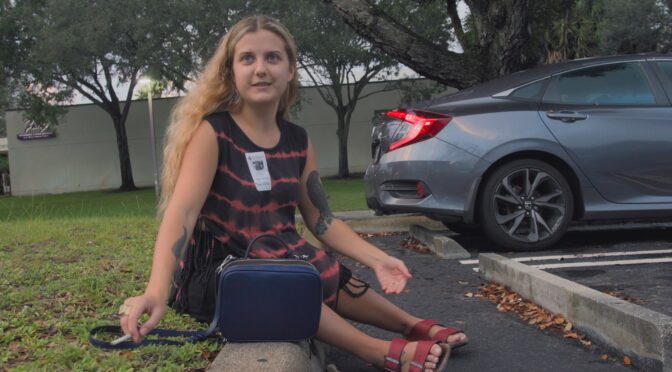Filmmaker Ella Glendining was born with a rare form of dwarfism – without hip joints and with extremely short femurs. Her condition makes her immediately, often unwelcomingly, visible in public spaces. This uneasy duality of hyper-visibility on one side and the misunderstood and under-representation of dwarfism and disability in the wider social consciousness on the other, forms the basis of IS THERE ANYBODY OUT THERE? – a self-documentary built from years-long archival footage of her life alongside her quest to find other people with the same condition.
The cinematographic scope and form of IS THERE ANYBODY OUT THERE? is limited by its reliance on interviews and the COVID-19 pandemic, which delayed outreach and meeting plans. Glendining also starts a family during this time, which throws up a whole new minefield of navigating a pregnancy and medical system when she and her practitioners both discover risks and possibilities together. The resulting film consequently has a video diary feel, but what it lacks in visual engagement is made up for in judicious editing and the eloquence, intelligence, and honesty of Glendining and her interviewees.
“The resulting film consequently has a video diary feel, but what it lacks in visual engagement is made up for in judicious editing and the eloquence, intelligence, and honesty of Glendining and her interviewees.”
Glendining, who maintains that ableism (and not her disability) has been the biggest barrier to her making a film career, never stops interrogating her perception of the world and its perception of her. The open-hearted engagement she maintains in the face of shocking questions and opinions is extraordinary to witness. Most of such comments and questions are seemingly well-meaning (though a doctor who has become famous for lengthening thigh bones and ‘curing’ disability feels darker). Still, by flipping the perspective, one hopes that IS THERE ANYBODY OUT THERE? encourages able-bodied audiences to examine their own prejudices and assumptions about disabled experiences.
“[Ella Glendining] is as exacting and rigorous with her assumptions as she is in challenging others, encouraging an empathetic reflection as the film’s ending scenes roll.”
The richest conversations are with other disabled individuals, and Glendining’s perspectives are broadened throughout her search for someone exactly like her – a journey that emerges organically and drives the film’s last half hour. She is as exacting and rigorous with her assumptions as she is in challenging others, encouraging an empathetic reflection as the film’s ending scenes roll. She spends lots of time talking over the project with her friend Naomi, who is autistic, and how their invisible versus visible disabilities come up against difficulties in an uncompromising world designed for the able-bodied and neurotypical. “Disabled kinship is key to disabled joy,” Glendining shares; in the end, IS THERE ANYBODY OUT THERE? is a cry for solidarity outside the bounds of what society considers normal – and an intellectual challenge to question what normal family structures, mental processing, or physical ability is in the first place.

